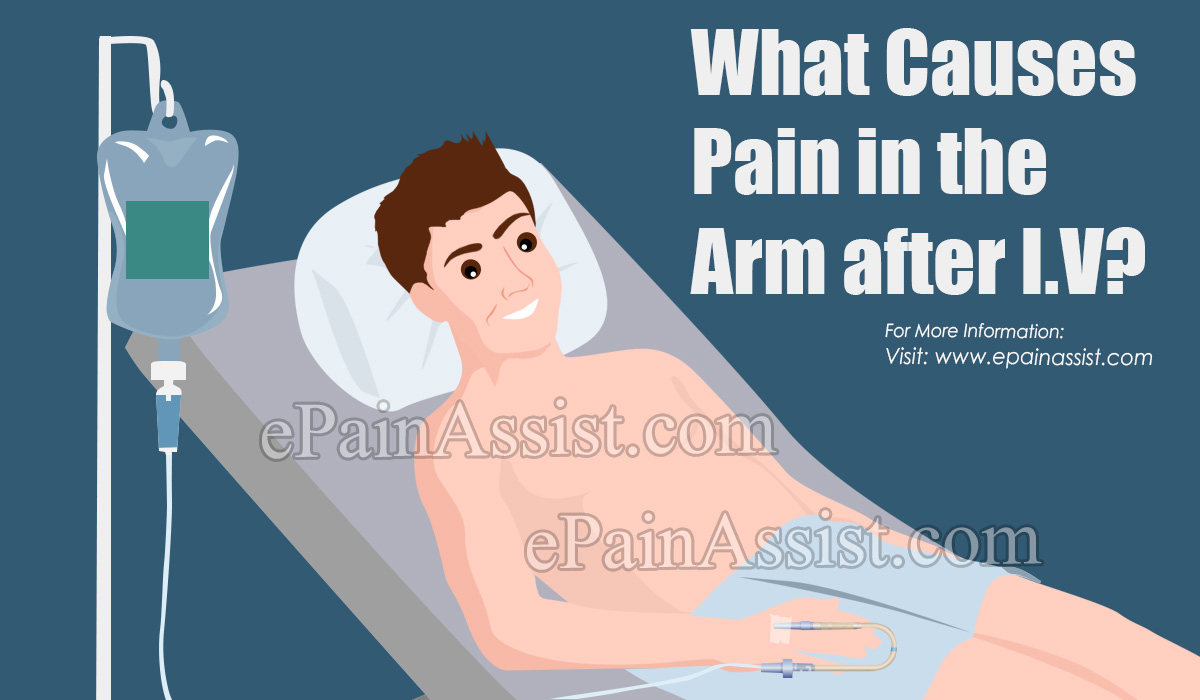I.V. or intravenous therapy is the common procedure done in hospitals to deliver fluids into the body directly through the veins. It is commonly referred as drips. I.V. is used for injecting liquids at high pressure or for infusing fluids using pressure by the gravity. It is the fastest way to introduce a medicine in the body or for other therapies such as fluid replacement. However, this procedure can be associated with pain or soreness at the sight of prick. This is often caused due to a condition called as phlebitis.

What Causes Pain in the Arm after I.V.?
Phlebitis is a medical condition associated with inflammation of vein which is elicited as pain and swelling over the affected area. During an I.V, fluids are introduced into the body through the veins in the arms which often causes trauma to these veins leading to phlebitis. This is the most common cause of pain in the arms after an I.V. It is generally a type of phlebitis called as superficial phlebitis where the veins on the skin surface are affected, rather than the deeper veins. When an intravenous (I.V) catheter is inserted into the vein, the vein gets irritated and thus gives rise to superficial phlebitis. In few cases, the phlebitis may be associated with a blood clot, which can further lead to serious complications.
Symptoms Associated with Pain in the Arm after I.V
Pain in the arm after an I.V or superficial phlebitis is often seen is association with the following symptoms:
Slow onset of a tender area (over the area of I.V introduction) along with redness of skin. A thin red area or inflammation may be seen along the course of affected vein. In some cases, a spider like pattern may be noted (in case of involvement of smaller feeder veins).
- The area may appear hard and warm along with pain and tenderness. Itchiness and swelling is a common finding.
- There may be throbbing or a burning sensation in the arm after an I.V.
- The tenderness may worsen with movement of the arm.
- In some cases, a low grade fever may be noted.
In the presence of an infectious condition, there may be worsening of the above mentioned symptoms.
Management and Treatment of Pain in Arms after an I.V
In most of the cases, pain in the arm after an I.V improves by itself and does not need any active treatment. However, if the condition does not improve, or if the pain worsens even after discontinuing the I.V, medical attention is necessary. Diagnosis involves taking a detailed case history from the patient followed by a physical examination. In most of the cases, no additional tests are required. However, if a blood clot is suspected (which is rare), specialised tests are ordered. Tests are done to rule out a serious condition called as deep vein thrombosis. These tests include blood work for checking D-dimer and clotting factors, ultrasounds, venography etc.
In most of the cases, self-care at home as mentioned are suggested, which are often beneficial in providing relief:
- Application of warm compresses over the affected site
- Over-the-counter anti-inflammatory medications such as Ibuprofen can help in management of pain and swelling over the I.V site.
- In case of superficial phlebitis associated with an infection, antibiotics are often prescribed to arrest the infection.
Prognosis of Pain in the Arm After I.V
Pain in the arm after an I.V or superficial phlebitis is rarely a serious condition. It resolves by itself in most of the cases. In other cases, it responds well to pain control medications and warm compresses. It is advised to change the line of IV therapy frequently to avoid development of soreness in the arms. Applying a cold spray prior to IV insertion can also reduce the pain associated with IV therapy. Pain in the arm after I.V associated with blood clot can lead to a condition called as deep vein thrombosis needs an immediate medical attention as it can lead to serious complications and even death.
Conclusion
I.V or Intravenous therapy is a medical procedure where fluids and liquids are introduced into the veins for its beneficial effects. This can often cause localized trauma or irritation over the site of I.V insertion (usually the arms) causing pain and soreness. This condition is called as superficial phlebitis. It is often associated with inflammation, redness, swelling and itchiness over the area along with worsening of pain with arm movement. In most of the cases, it is a self-limiting condition, i.e. it does not need any treatment and improves by itself in a couple of days. Warm compresses and anti-inflammatory medications are known to provide relief. It is generally suggested to change the line of I.V to prevent occurrence of this condition. Pain in the arms after an I.V is very common and there’s nothing to worry about. However, if the pain does not resolve or worsens over a period of time, it may indicate presence of a blood clot which may in turn be associated with a condition called as deep vein thrombosis (DVT). DVT is a serious medical condition that needs immediate medical treatment to avoid development of complications.
Also Read:
